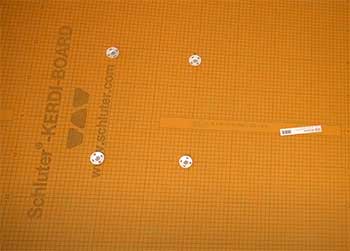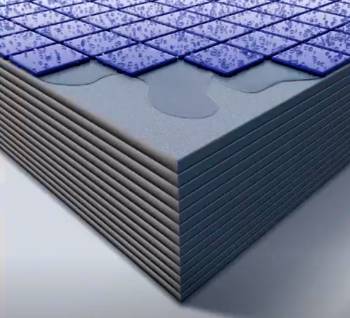The area of a shower/bathroom is always moist. Both the wall and floor of the bathroom need extra protection from moisture.
Tile substrates can be an easy solution to this problem because they protect your bathroom wall and floor from the cavity, which can happen due to the extra moisture.
But you might be wondering which tile substrate can be the best fit for your bathroom. If you are in a dilemma and confused with the DensShield vs. KERDI-BOARD comparison, then this article is for you.
A Quick Comparison Table
| Specification | DensShield | KERDI-BOARD |
| Type | Backer | Waterproofer |
| Manufacturer | Georgia-Pacific Building | Schluter |
| Materials | Waterproof silicon-based gypsum, fiberglass mats on the back and front. | Extruded polystyrene hard foam panel, cement-free unique reinforcement material with a fleece webbing. |
| Thickness | 5/8” (15.9 mm), 1/4” (6.4 mm), and 1/2” (12.7 mm) | 2″ (5, 9, 12.5, 15, 19, 25, 38, and 50 mm) , 3/16″, 3/8″, 1/2″, 5/8″, 3/4″, 1″ and 1-1/2″ |
| Rigidity | More rigid than KERDI-BOARD. | Comparatively less rigid |
| Weight | Heavier than KERDI-BOARD | Less Heavy |
| Mold Resistance | Yes | Yes |
| Installation | Takes less time | Takes more time than DensShield |
Differences Between DensShield And KERDI-BOARD

Now let’s dive deeper into the differences between the two substrates in terms of a few factors.
- Type
Though DensShield and Kerdi board both work almost the same, they are two different kinds of products.
Both board types are used for extra protection and as a tile substrate, but DensSheild is a type of backer while KERDI-Board is a waterproofer.
Backer board is usually made of cement, silica, fiberglass, which is one of the main elements of DensShield. That is why DensShield is called a tile backer.
On the other hand, the Kerdi board is called a waterproofer because of its hard XPS foam.
- Manufacturer
Georgia-Pacific Building is the primary manufacturer of DensShield Tile backer, while Schluter is the manufacturer of KERDI-BOARD. Both companies are well known and try to serve the best product.
But there was a shortage of Schluter’s Kerdi-Board for a certain period, leading to customer dissatisfaction.
- Materials
Some significant differences can be noticed in the material of these two kinds of tile substrates.
DensShield tile backer is made of waterproof silicon-based gypsum, fiberglass mats on the back and front. Its structure is almost similar to fiber cement board. This kind of material makes DensShield stronger than Kerdi Board.
On the other hand, the Kerdi board is made of extruded polystyrene hard foam panel, cement-free unique reinforcement material with a fleece webbing.
- Thickness

When it comes to the matter of variety on thickness, you might find Kerdi-board as the best option.
2” (5, 9, 12.5, 15, 19, 25, 38, and 50 mm), 3/16”, 3/8”, 1/2”, 5/8”, 3/4”, 1” and 1-1/2” – all those varieties will give you the perfect match according to your demand.
DensShield has slightly fewer options, but 5/8” (15.9 mm), 1/4” (6.4 mm), and 1/2” (12.7 mm) will do your work.
- Rigidity and Weight
DensShield is comparatively more rigid because of its material, while Kerdi board is not as rigid as DensShield. For the same reason, Kerdi-Board weighs less than DensSheild.
But it’s not an issue after installing the tiles. Rather it gives Kerdi board an extra advantage while installation because of its lightness.
- Installation
DensShield does not require any specialized tools, fasteners, or extra membrane for tile installation. DensShield protects both sides of the wall, and you can even install it on the drywall.
Kerdi-board installation process is a little bit difficult and requires more time than DensShield’s because it also needs Kerdi membrane. Another problem is that installing it on drywall won’t protect the other side of the wall.
DensShield Or KERDI-BOARD?

Let’s first talk about DensShield and its characteristics for your better understanding.
DensShield is a kind of tile substrate that is used in wet areas like bathrooms and kitchens.
It works as a barrier for the wall and protects the wall from the effects of tile installation and the wall cavity.
DensShield is also used in non-wet areas of the house. Sometimes it is used as a cheaper alternative to tile by being applied with different colors.
As the surface of the DensShield is very smooth, it looks good on the wall when painted even without the tile.
But it is mainly used as a base of the tile installation in the bathroom. That is how the tiles do not come in contact with the wall and floor directly.
DensShield helps to keep the wall dry and free from moisture constantly.
Schluter KERDI BOARD is another kind of tile substrate which prevents water from coming into the wall.
KERDI BOARD is also used to build different types of elements that might be square, triangle, flat, upright, or level. In addition, KERDI BOARD is waterproof, and Schluter claims that as a temperature resistance option.
The primary purpose of a KERDI BOARD is almost the same as that of DensShield, which is to protect the wall from the cavity and any sort of damage after tile installation.
Despite having the same purpose, the two tile substrates have some significant differences.
As you are perfectly aware of their differences, assess your own need and go for anyone that will match your best interest.
Frequently Asked Questions (FAQ)
Let’s discuss a few frequently asked questions and our answers to them.
DensShield tile backer is cheaper than Kerdi-board. But if you want detailed framing in your shower, Kerdi-board would be the easiest option.
There are two methods to connect Kerdi-board to a bathtub – installing over the lip of the tub and installing flush with the lip of the tub. Kerdi-board shower system handbook has all the instructions and details that you can follow.
You can install the tile right away, but it is recommended to wait until you make sure that all the bonding materials stabilize the assembly of Kerdi-board.
For DensShield, the answer is no. Any dry-set or thin-set tile mortar can be used on DensShield. But for Kerdi-board, unmodified thin-set mortar is a must.
Both can be used in floor applications. But in extreme wear and heavyweight condition, DensShield is preferable as it works almost like cement or fiber cement backers.
Final Words
DensShield vs. KERDI-BOARD is not an easy comparison and requires more understanding to take the final decision. But once you are sure about your goals and how you want to get the work done, you’re halfway there.
In case of showing creativity and doing something fancy on the bathroom panel, Kerdi-board is the best option. On the other hand, DensShield can give you a quick and cheaper installation.
However, as DensShield puts up with nails and screws, waterproofing is not a hundred percent guaranteed. Though the leakage with DensShield is very rare, you may want to go for Kerdi-board if you’re a perfectionist.

This post may need updating. A guy on youtube says that Shulter now recommends a modified thinset mortar. Might want to look into that before you buy your thinset.